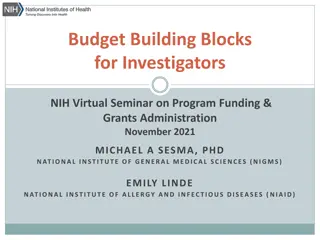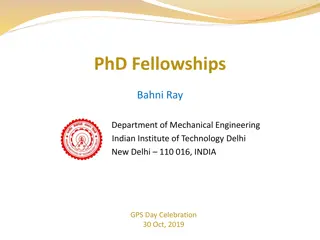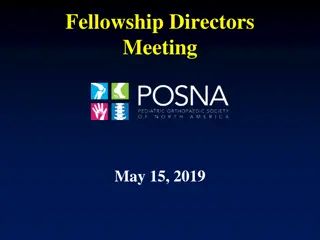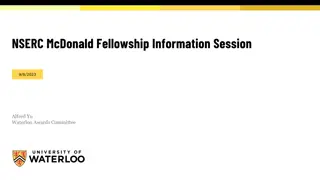
NIH Predoctoral Fellowship Biosketch Guidelines & Tips
"Learn about the crucial details for creating an effective NIH predoctoral fellowship biosketch. Understand the required formatting, citations, and use of SciENcv for a successful application."
Uploaded on | 0 Views
Download Presentation

Please find below an Image/Link to download the presentation.
The content on the website is provided AS IS for your information and personal use only. It may not be sold, licensed, or shared on other websites without obtaining consent from the author. If you encounter any issues during the download, it is possible that the publisher has removed the file from their server.
You are allowed to download the files provided on this website for personal or commercial use, subject to the condition that they are used lawfully. All files are the property of their respective owners.
The content on the website is provided AS IS for your information and personal use only. It may not be sold, licensed, or shared on other websites without obtaining consent from the author.
E N D
Presentation Transcript
NIH Predoctoral Fellowship Biosketch 08 November 2022 Lauren B. Armstrong Assistant Director, Office of Grants and Contracts UVA School of Medicine lpb4c@virginia.edu
THE BASICS o A biosketch documents an individual's qualifications and experience for a specific role in a project think of this as your grant-specific resume or CV o NIH uses the biosketch to evaluate and ensure that an individual s skills, knowledge, experience, and resources are sufficient to carry out the proposed research o Specific formatting is required for compliance with application guidelines o Font size 11pt or larger, no more than 15 characters per linear inch, no more than six lines per vertical inch o Recommended fonts: Arial, Georgia, Helvetica, Palatino Linotype (other fonts are acceptable if they meet the above requirements) Margins at least one-half inch ( ) for all sides o Do not include headers or footers o Page limits maximum of five letter-sized (8 x 11 ) pages o Miscellaneous o Filename maximum 50 characters or less (including spaces) o Disable any security/encryption features and do not use password protection o
THE BASICS - continued Citations o Any format is acceptable NIH does not require a specific format o Use of et al is acceptable o NIH suggests using the National Library of Medicine s standard format if you do not otherwise have one o See Citing Medicine, 2nd edition o Remember to comply with the NIH Public Access Policy when citing applicable papers that arise from NIH-funded research o Include the PMCID reference number [DOIs and/or PMIDs are allowed but not required] o Do not use hyperlinks for citations o o Don t recreate the wheel utilize SciENcv! o Science Experts Network Curriculum Vitae o https://www.ncbi.nlm.nih.gov/sciencv/ o Synchronize with eRA Commons Personal Profile information o Create and save multiple versions o Share with collaborators or administrative staff o Automatic formatting
THE BASICS - continued o NIH Fellowship Biosketch o Blank Format Page o Instructions o Predoctoral Fellowship Sample o FAQs
SECTION A. PERSONAL STATEMENT o Briefly describe why you are well suited for your role on this project Training, previous experimental work on specific or related topics, technical expertise, collaborators/scientific environment, past performance in this or related fields and any completed or ongoing projects that you would like to highlight o Cite up to four publications or research products that highlight your experience or qualifications (audio/video products, abstracts, posters/presentations, patents, data or research materials, databases, models, protocols, software, instruments/equipment, etc) o o Address any factors that may have affected past productivity (family care responsibilities, disability, military service, etc) Indicate any publications or other products created under another name o o Do not include figures or graphics Tailor this section to the project at hand o
SECTION B. POSITIONS, SCIENTIFIC APPOINTMENTS and HONORS o List in reverse chronological order all current positions and scientific appointments both domestic and foreign, including affiliations with foreign entities or governments Titled academic, professional, or institutional appointments whether or not remuneration is received, and whether full-time, part-time, or voluntary (including adjunct, visiting, or honorary) o o List any relevant academic and professional achievements and honors Scholarships, traineeships, fellowships, and development awards o o List current or pending participation in, or applications to, programs sponsored by foreign governments, instrumentalities, or entities, including foreign government-sponsored talent recruitment programs
SECTION C. CONTRIBUTIONS TO SCIENCE o Describe up to five of your most significant contributions to science No longer than one half-page each, including citations o o Content: o the historical background that frames the scientific problem o the central finding(s) o the influence of the finding(s) on the progress of science or the application of those finding(s) to health or technology o your specific role in the described work For each contribution, you may cite up to four publications or research products that are relevant (note your role if you are not the author) o You may mention manuscripts in process, but you may only cite published works o o Figures, tables, or graphics are not allowed Hyperlinks and URLs are not allowed o You may provide a hyperlinked URL to a full list of your published work. This hyperlinked URL must be to a Federal Government website (a .gov suffix). NIH recommends using NCBI My Bibliography. o
SECTION D. SCHOLASTIC PERFORMANCE o List by institution and year all undergraduate and graduate courses, with grades o Explain any grading system used if it differs from a 1-100 scale; an A, B, C, D, F system; or a 0-4.0 scale o Indicate the levels required for a passing grade






















